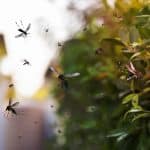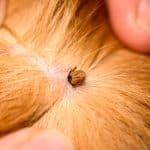As the temperatures start to climb, an array of winged insects will begin to make their presence known. While many will often be seen landing on flowers or making an appearance around backyard gatherings, it still might be difficult to quickly determine what types of flying insect you are dealing with. And, no matter what precautions you might take, there’s a good chance that you will encounter a bee, wasp, or hornet in the upcoming months.
Even though these pests all fly and are capable of stinging, the differences between bees, wasps, and hornets are pretty remarkable. Since the likelihood of encountering each is incredibly high and dangerous if an allergy is present, it is essential to understand the many differences between these pests, including their stinging capabilities, habitat preferences, and visible characteristics. With this handy guide, you will know what you are dealing with and the best ways to avoid them whenever possible.
A Closer Look at Bees
Most people will know a bee when they see it; however, knowing what you are dealing with may be a little more challenging when it is in the same vicinity as a wasp or hornet. The most common types of bees that Oklahomans will run into are bumblebees, honeybees, or carpenter bees. Both bumblebees and carpenter bees are rounder and feature black and yellow colors. Honeybees are often much smaller and have a banded orange-yellow and black or brown color – although they also look hairy.
When determining the type of habitat most suited for bees, it is crucial to understand that not all species prefer the same environment. For instance, honeybees will often build hives inside hollowed-out trees while bumblebees will find available cavities – often leftover by burrowing rodents. However, both will often be seen around flower beds and gardens looking for nectar. Carpenter bees again have different habitat preferences and prefer to nest in a variety of wood types. Although, they generally prefer partially decayed trees, unpainted wood, or exposed structural timber.
One final thing to keep in mind is that when a bee stings, its stinger will detach and continue to pump venom. This makes it particularly dangerous for individuals with an allergy to them, but for most people, the pain will be short-lived and paired with swelling and itching. Some species of bees, like honeybees, will die once their stinger is used; however, ground-nesting bees aren’t considered aggressive and will rarely sting a person.
Not sure if you are dealing with bees, wasps or hornets?
Give Emtec Pest Control a Call! One of our friendly and experienced technicians can help identify any flying insects present and provide a free estimate to remove them.
A Closer Look at Wasps
While many people lump wasps and hornets together, these pests are not the same, and a “hornet” is just a type of wasp. In Oklahoma, paper wasps and yellow jackets are among the most common wasp species that can be found around a home’s eaves. In general, wasps will have a narrow, pinched waist and will take on a predominately black color with yellow, orange, or white markings. While yellow jackets often have the same color patterns as bees, they do not look hairy.
Wasps will generally search for nesting locations that provide shelter from the elements. In many cases, this leads homeowners to find wasps frequenting gutters, bushes, fences, tree branches, leaves, or wall voids when they are building new nests. These pests will also gravitate to backyard grills or barbecues because they prefer meat. Unfortunately, this leads to many unwarranted stings when people eat food outside and try to “shoo away” wasps searching for food.
Unlike bees, wasps are capable of stinging multiple times because they do not lose their stingers and often will if they feel threatened. Although this may seem like a scary scenario, people are usually only stung if they get too close to a nest or inadvertently disturb a nest. Often, the best thing to do when a wasp is nearby is to leave it alone. Any swats or sudden movements could be interpreted as an act of aggression that leads the wasp to feel unsafe and attack.
A Closer Look at Hornets
Perhaps the largest of the three species represented in this article, hornets are a type of wasp. In Oklahoma, both the European Hornet, also known as the brown hornet, and the bald-faced hornet is perhaps the most common. Interestingly, the bald-faced hornet is not actually a “true hornet” and is only classified as one because of its large size compared to other wasp species. European hornets are often identified by their predominately reddish-brown coloring with yellow stripes along the abdomen. In contrast, bald-faced hornets have a primarily black pattern with white markings on their face.
The habitats that are most likely to be considered home for hornets can vary widely depending on the hornet species. For instance, bald-faced hornets may choose to nest in exposed areas like tree branches, utility poles, or shrubs, while the European hornet will likely nest inside of barns of hollowed trees. With this variation in mind, people need to understand that these pests may be found in many different locations that provide a suitable environment for them.
Hornets have one of the most devastating stings of the pests represented in this article. This is further compounded by the fact that hornets will sting whenever they feel threatened and can be incredibly aggressive around nesting areas. Most people will experience severe pain, swelling, and redness around the sting site; however, severe pain and life-threatening injury are possible an allergic reaction occurs. If possible, hornets should be avoided at all costs, and professional removal is always recommended.
At Emtec Pest Control, we are committed to safe and responsible pest control. We understand that your family’s safety is your number one priority, so we make it our priority, too. If you have any other questions about any of these pests or pest control for your home or business, contact your Oklahoma pest control experts at Emtec Pest Control by calling us or by filling out our online contact form. Our service areas in Northeast Oklahoma include Bixby, Broken Arrow, Catoosa, Owasso, Jenks, Sand Springs, Sapulpa, Skiatook, Stillwater, Tulsa and the surrounding areas. In Central Oklahoma, we service Edmond, Moore, Oklahoma City, Yukon and the surrounding areas. You can also connect with us on social media for more helpful pest control tips and information. We are on Facebook.-





